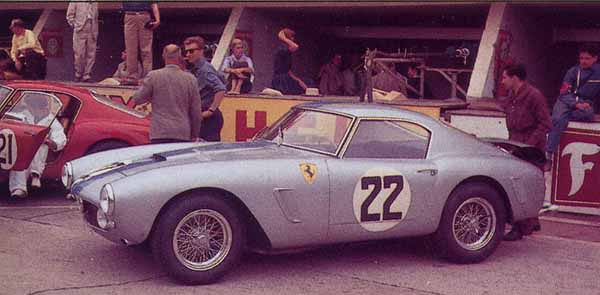
| HISTORY |
Starter 1/43 Ferrari 250 GT SWB(Short Wheel Base)
| KIT #: | 56 |
| PRICE: | $21.00 (second hand) |
| DECALS: | None |
| REVIEWER: | Scott Van Aken |
| NOTES: | Resin body multimedia kit. |

| HISTORY |
One of the most notable GT racers of its time, the 1959 250 GT Berlinetta SWB used a short (2,400 mm (94.5 in)) wheelbase for better handling. Of the 176 examples built, both steel and aluminum bodies were used in various road ("lusso") and racing trims. Engine output ranged from 240 PS (177 kW; 237 hp) to 280 PS (206 kW; 276 hp). The "lusso" road car version was originally fitted with 185VR15 Pirelli Cinturato (CA67).
Development of the 250 GT SWB Berlinetta was handled by Giotto Bizzarrini, Carlo Chiti, and young Mauro Forghieri, the same team that later produced the 250 GTO. Disc brakes were a first on a Ferrari GT, and the combination of low weight, high power, and well-sorted suspension made it competitive. It was unveiled at the Paris Motor Show in October and quickly began selling and racing. The SWB Berlinetta won Ferrari the GT class of the 1961 Constructor's Championship.
In 2004, Sports Car International placed the 250 GT SWB seventh on a list of Top Sports Cars of the 1960s, and Motor Trend Classic placed it fifth on a list of the ten "Greatest Ferraris of all time".
| THE KIT |
 I
mentioned earlier that one of the three major 1/43 multimedia car kit makers was
Starter. This is very much typical of their work in that they have a resin body
and
interior/pan. There are pips on the resin pieces where the mold bits have been
cut away. Air bubbles are present, but mostly on the lower part of the body.
These are easily filled and are normal for these kits. There was one air bubble
on the top of the driver's seat. This one is a
bit different as it has some very nicely done wire wheels in metal/p.e. already
assembled. It has metal for the gas cap on the back and head light bezels. The
head lights are in resin. Tires are a rubber or vinyl and still fairly soft.
There are a pair of body screws and a plastic steering wheel. No gear shift
lever, but easy enough to make from a straight pin or section of wire. There is also a single vacuform windows piece.
Not shown is a piece of tubing, undoubtedly for either the axles or the exhaust.
It will need to be cut.
I
mentioned earlier that one of the three major 1/43 multimedia car kit makers was
Starter. This is very much typical of their work in that they have a resin body
and
interior/pan. There are pips on the resin pieces where the mold bits have been
cut away. Air bubbles are present, but mostly on the lower part of the body.
These are easily filled and are normal for these kits. There was one air bubble
on the top of the driver's seat. This one is a
bit different as it has some very nicely done wire wheels in metal/p.e. already
assembled. It has metal for the gas cap on the back and head light bezels. The
head lights are in resin. Tires are a rubber or vinyl and still fairly soft.
There are a pair of body screws and a plastic steering wheel. No gear shift
lever, but easy enough to make from a straight pin or section of wire. There is also a single vacuform windows piece.
Not shown is a piece of tubing, undoubtedly for either the axles or the exhaust.
It will need to be cut.
In line with other cars I bought from this same vendor, there are no instructions. Now I know that with racing cars from other lines I've had instructions so I'm not sure if they are supposed to come with them or not. It actually doesn't matter all that much as the parts count is relatively low and assembly should be pretty easy, but it would be nice to have anyway. What is included is a decal sheet with two racing options and a set of placement instructions. Not sure how viable the decals are, but at least there are some I can use for tests. One of the markings options is the car shown in the header image. Note that this one does not have the vent windows. The kit does have them and supplies them as part of the vacuform windows.
| CONCLUSIONS |
This should make into a very nice model. The only reason I've shown all the parts laid out like this is that the plastic bag in which all the little bits were held had deteriorated so badly that they bits were loose in the box. This is an issue with old French resin car kits, so keep that in mind when buying one second hand. The end result will be a very nice model and one that I know I'll enjoy adding to my collection.
| REFERENCES |
https://en.wikipedia.org/wiki/Ferrari_250
June 2017
Copyright ModelingMadness.com. All rights reserved.
If you would like your product reviewed fairly and fairly quickly, please contact the editor or see other details in the Note to Contributors.
Back to the Main Page Back to the Previews Index Page Back to the Review Index Page